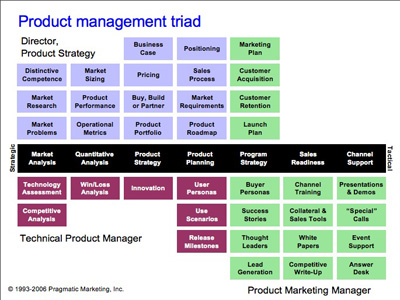 I was going to write a big entry about ethnography as a design tool, but that got me to thinking a more basic question: in your organization, who does product design?
I was going to write a big entry about ethnography as a design tool, but that got me to thinking a more basic question: in your organization, who does product design?
First, we have to define “design” a bit more clearly. I’m talking primarily about software products here and I’m talking about under-facing interaction design. Not user interface design, because that the term “user interface”, while common, doesn’t really capture the more extensive idea of user interaction, which is more than just where the buttons are on the screen.
So, who’s doing it? You? A developer? If so, do either of know what you’re doing? Really?
Let’s check the Pragmatic Marketing grid:
Hm, no design there. And your developer? Does he (or she) really know anything about design? Maybe, maybe not. My point is this: it’s my experience that most software development organizations, especially “enterprise” software, lack any product designers. There’s a developer with a flair for it, there’s a graphic designer that you wrestled away from marketing for a day or two to do your icons, but there’s really no one doing serious interaction design.
If you’re a web design firm, things are different. Web designers, typically being consumer-oriented, are very focussed on user interaction as well as graphic design. Look at how we describe them: “web” “design” firms. It’s about the web and it’s about design. Only recently, with the surge of interest in DSLs like Rails, have these web people have been doing anything interesting from an engineering point of view. So the web people seem to have it all these days. But in enterprise software, things are not so great – it’s about “enterprise” and “software”; “users”, “design” and “enjoyable experiences” don’t come into it.
So I’ve made the unsubstantiated statement that software development organizations lack interaction designers. But all is not lost. There’s a lot that you, as a product manager, can do to improve your product without resorting to pretending that you’re an interaction designer.
If we refer back to “The Grid”, there are three items right in the middle that form the foundation under any design efforts: “User Personas”, “Use Cases” and “Buyer Personas”. There are some very good books that talk about persona-based design, like Cooper’s “The Inmates Are Running The Asylum.” Building strong, compelling personas is an essential step to building a product that has clear, compelling value to prospective users. I saw this firsthand when Alan (Armstrong, not Cooper) put together the personas* for PerformaSure (he and I did a lot of customer calls together for this).
How do you build these personas and uses cases? By talking to a lot of users. But not just talking to them without any sort of plan, You need to build an ethnography.
* I like using the latinate “personae” instead of “personas” but avoid doing so in actual discussions at work because it sounds somewhat pretentious. Even though it’s correct.
